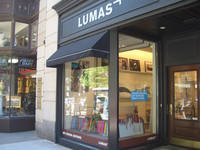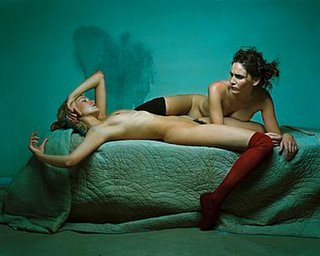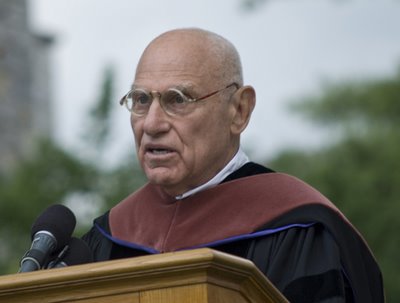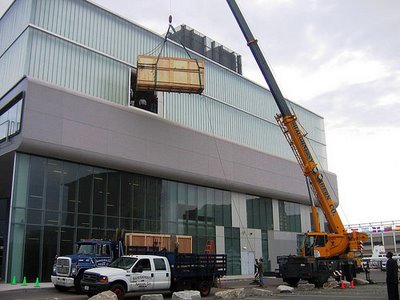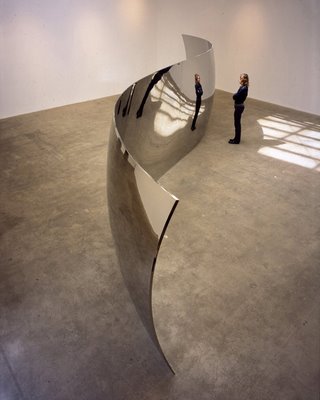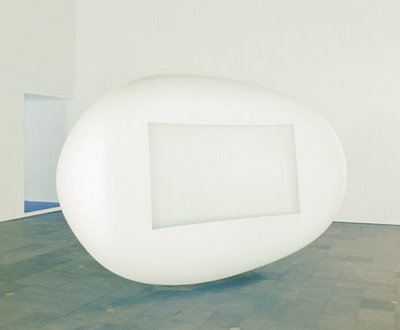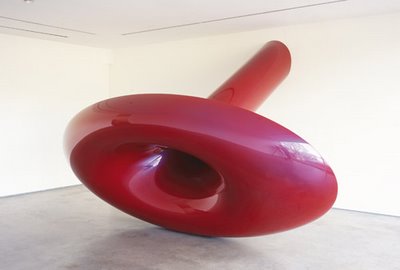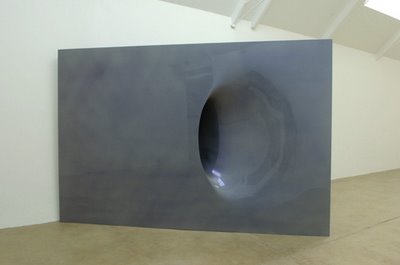 Radio Boston
Radio Boston’s May 27 program “Public Art” sounded an alarm about “the privation of public art” in Boston. Its main point was summarized by Ricardo Barreto, director of the
UrbanArts Institute at MassArt: “The politicians need really to see that there’s a void in Boston. And other cities are filling it and we are not. And there are economic implications. The other cities that are filling the void are joining the 21st century, and if we don’t’ fill that void we will be stuck somewhere else.”
Perhaps.
The Boston area actually is rich in public art – but in keeping with our area’s historical bent, much of it is
old. We do have two significant contemporary sculpture parks: UMass Boston’s “Arts on the Point” (a mixed bag, but it has Mark Di Suvero's great “Heru’) and the
DeCordova Museum and Sculpture Park in Lincoln. (Although, I'm not quite sure if DeCordova counts as public.) And we do continue to produce major, quality public artworks, like the
New England Holocaust Memorial, which was dedicated in 1995, in downtown Boston, near Faneuil Hall, on the Freedom Trail.
But assuming we might be failing to join the 21st century with public art, I’m not sure that any of the people on the program are the right folks to lead us there (here?). The program was too focused on the art of public art and not enough on the public. So the show’s brand of public art seemed, like most art, to be about stuff for a relatively small, elite audience of white people – but colonizing public spaces.
This was apparent in the program’s focus on downtown Boston and
Cambridge, with the rest of the area basically ignored. The show noted that local public sculpture is dominated by old dead white guys in metal, but after raising this issue of race and gender, it did little to examine how public art addresses these communities. It ignored all the murals in Roxbury – like the murals depicting musicians on Ferdinand’s Blue Store in Dudley Square (pictured above), the Negro League stars mural at the corner of Stoughton Street and Columbia Road in Uphams Corner, and the
“Faces of Dudley” mural (including Malcolm X) in Dudley Square. These murals show that a major benefit of public art is that it frequently addresses subjects that are mostly off the radar of the art world – in this case the history and accomplishments of African Americans, and in particular Roxbury residents. Augustus Saint-Gaudens’ 1897
“Memorial to Robert Gould Shaw and the Massachusetts Fifty-fourth Regiment” at Boston Common is another example of this.
While I support public art in general, we can’t overlook that most art ain’t that great – and public art is no exception. The difference is that public art occupies public spaces, and tends to be on display longer than most art. So it deserves caution. Perhaps we should review public art every 15 to 20 years to see if it still deserves its public spot. Perhaps with neighborhood (i.e. public) referendums.
During the radio program, Barreto made the common mistake of using the term “art” to describe the quality of something, rather than a type of thing: “You have to really wonder with something like this how much of this is really art and how much of this is sort of craft and kind of a social, cultural manifestation at a different level. Which doesn’t mean it’s bad, it just means it’s different.”
This is a retrograde, 19th century idea of what art can be. Since Marcel Duchamp “discovered” the ready-made in 1915, the definition of art has happily expanded to include nearly everything – and then we decide how successful that art is. If we’re really concerned with “joining the 21st century,” we need to approach public art with this
more inclusive criteria in mind.
When it comes to public art, aesthetic and intellectual enrichment is just one of the factors we should consider when deciding whether a piece is successful – and it may not ultimately be the most important one. Other criteria that should be addressed: does it provide entertainment, embody the nature of its location, become a landmark, become an icon representing its location, become embraced by the community?
One of the most successful pieces of public art in the region is
Gloucester’s Fisherman’s Memorial. The sculpture itself is okay – a traditional realist monument depicting a fisherman at a ship’s wheel facing out to sea, with the inscription “They that go down to the sea in ships, 1623-1923.” But it directs our gaze out to sea, we are on the ship with the man. It has come to serve as a place of public remembrance – where lives lost at sea are recalled, and annual community memorial events are held. Tourists come just to see it. And it has become a landmark and a symbol, an icon or logo of Gloucester.
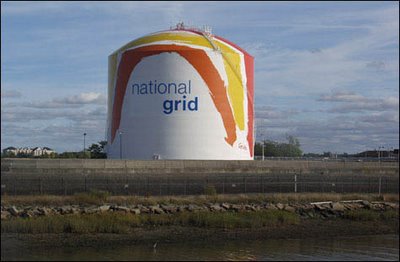
Boston’s most prominent piece of public art is
Sister Corita Kent’s rainbow-striped
gas tank off Route 93 in Dorchester (pictured above). It’s kind of cheesy, but it brightens its location, and has become a landmark.
Come to think of it, an even more notable landmark piece of Boston public art is the
Citgo advertising sign in Kenmore Square (which looks like a light-up ‘60s Frank Stella). It may not have originally been public art, but it became some sort of mutant advertising-pop art hybrid after community (i.e. public) opposition stopped the oil company from demolishing it in 1983.
How do we foster more of this sort of public art? And even better quality pieces?
Radio Boston harped on government funding for public art. But funding is just as much the artists’ responsibility. Part of being a successful public artist is navigating the logistics – political, community, financial, construction – required to make the work happen.
Artists can’t just wait for government handouts. It’s worth noting that Kent’s rainbow mural is on private property and was funded by the private owner (Boston Gas, now Keyspan). And the Citgo sign is/was a corporate advertisement. This is not simply about public funding. Note that Boston’s Museum of Fine Arts just secured private funding to acquire those
crappy giant bronze baby heads by Antonio Lopez Garcia that have recently served as hood ornaments for the museum.
[Also note that though
Anish Kapoor’s masterpiece public sculpture “Cloud Gate” is in a public park in downtown Chicago, it took significant private funding to get it built. And I recall that the mayor there used this
private funding as a way to skirt much public oversight – which may not be how we want to go. And it
required immediate repairs, which nearly doubled its budget. But, man, is it a success now.]
And if we’re concerned about public art it’s probably not helpful to focus too much on the success – or lack thereof – of individual artists. Radio Boston placed a major focus on the plight of
Mags Harries of Cambridge. During the program, former Boston Globe critic Christine Temin said Harries had given up applying to do public art in Boston because she’d been rejected so many times. In fact, Harries may have more public art on view here than any other artist. Her permanent (or at least long-term) local art projects for government entities include: “Asaroton [Unswept Floor]” (1976) for Boston’s Haymarket; a 1983 gateway inside Cambridge’s Longfellow Elementary School; “Glove Cycle” (1984) for the MBTA’s Porter Square station in Cambridge; “Ben’s Circular Tower” (1994) in Mission Hill for the city of Boston with funding from the city’s Browne Fund; and “Drawn to Water” (1997-2002) at Cambridge’s Water Treatment Plant.
Perhaps the real question with Harries is whether other local artists need to be given a chance.
Like all art, the state of public art here depends on a combo of creativity, encouragement and serendipity. Boston still struggles with finding its way as a creative community. On this subject, it’s worth re-reading
AS220’s 2004 essay “Compost and the Arts: How to keep the arts from dying of old age.” It argues that to foster creative communities we need to support inexpensive artist live-work spaces, shared work spaces, places to display posters to share information, and places for the art community to hangout and trade ideas. “The result of policies like this will be ferment,” the paper argues. “Not all of what grows out of it will be great art, but experience shows that with enough ferment, some will.”
Determined artists find ways of making things happen – like
Matthew Hincman, with his guerilla art park bench that he snuck into Jamaica Pond, and Providence’s
Apartment at the Mall gang.
Major art movements have often begun with small groups of people – the cubists began with just two or three guys; abstract expressionism originated among about a dozen people. Improving public art here may just come down to getting a few interesting, motivated people in the right places – art world, financing, or government. Or maybe just one well-placed person.





